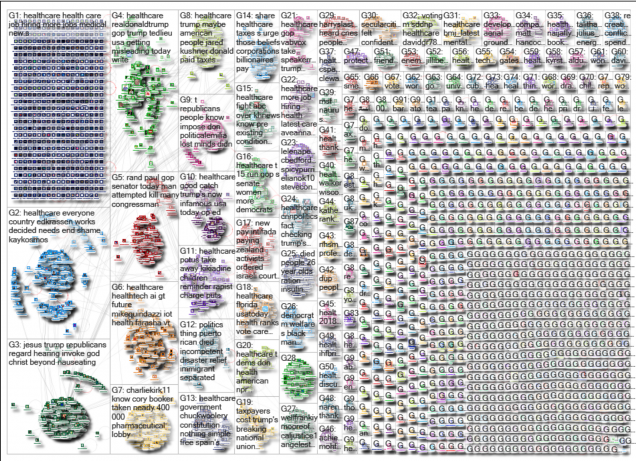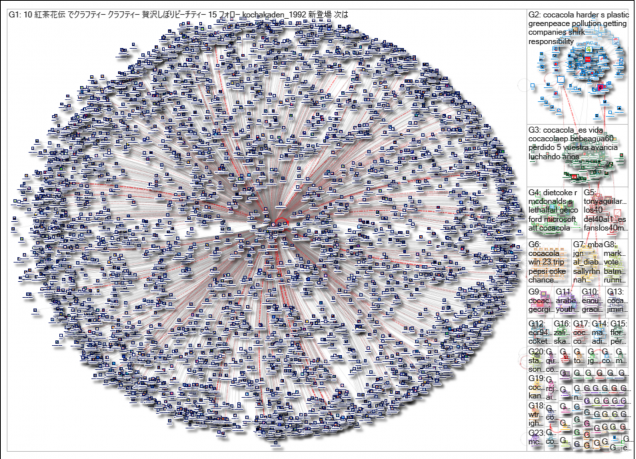The social media landscape has evolved into a complicated and large virtual world where knowledge sharing, public discussion, people take part in. Empowered by technology, anyone could create contents and easily reach to the wide audience. In another way, the boundaries between producers and customers are become blurred (Ranie Lees., 2012). However, not all content created by people could directly be spread to wide-audience or make wide connections and impacts. In fact, the distribution of content among the public is mediated by social-technical mechanisms, which provides the audiences with information and generate them into various groups, larger or smaller (Smyrnaios Nikos, 2018). The mediator under the social media context is network creator, whose different attributes lead to different structures or map of the social media network. The map of social media network that researchers are contributing to could identify differences in network structures, the connections among each person, influences from the leading speakers, trends, and topics. According to researches done by Smith, there are six social networks structure archetypes based on differentiated group topics and sizes as shown in F1, including divided, unified, fragmented, clustered, in-hub and out-hub. Using NodeXL, a network analysis, and visualization tool, researchers could generate network maps with reports of key people, groups, and topics. ( Marc. A Smith, etc., 2014).
1. Healthcare

F1: 6992 tweets contain “healthcare” in twitter
https://nodexlgraphgallery.org/Pages/Graph.aspx?graphID=171505
A network graph of #healthcare is a good example to illustrate the brand cluster structure. The graphs investigate 6,992 Twitter users whose tweets contained “healthcare” collected between 11 October 2018 to 14 October 2018. (F2) The brand cluster network usually has low density and many isolated participants. According to Smith, when people talk about brands (advised products), popular subjects, public events, and major news events, the brand cluster network has a tendency to generate. Under this condition, these topic attracts a large fragmented population who tweet about the topic but they won’t talk with each other and make connections like the clustered or unified network structure.
In this graphs, most nodes are separated without edges connecting each other. Healthcare is a general, well-known social topic, in which case, people from different background, hobbies, and ages, genders may reach to the topic. Without similar background or similar interested points, people talking about this general topic lack motivation to make connections. In this graph, a large proportion of people tweet with #healthcare for healthcare job hiring news or information, which for reminders or news display, rather than generating argues or discussions.
Meanwhile, it also generates some small groups, where people share and connect for some sub-topics. People may talk about healthcare taxes or healthcare beliefs (G14) or healthcare government (G13). Although there are some groups, these groups are small and disconnected compared with the unified structure. Under the brand network structure, there is limited interaction between users and little overlap in terms of the content that is shared and the resources to which they link. (Simth, 2012). In this graphs, people are using different hashtags and there are not many common links they share according to the report. In one word, the affordance of this network are high since no matter who you are, you could engage with this network from various angles. On the other hand, the degree of interactivity and tightness are relatively low.
2. WorldofCocaCola

F2: 4688 tweets contain “WorldofCocaCola” in twitterhttps://nodexlgraphgallery.org/Pages/Graph.aspx?graphID=171460
This network graph (F3) is a good example of a support network. The graph represents a network of 4,688 Twitter users whose tweets contained “WorldofCocaCola” collected between Saturday, 13 October 2018 at 08:17 UTC to Sunday, 14 October 2018. Usually, the center of the support network is a company account, setting for listening to and reply to user complaints and issues. Therefore, the center could reach to wide audiences while the users don’t connect with each other.
“WorldofCocaCola” is seen as a brand topic while the network graphs of “WorldofCocaCola” is embedded with the brand features while serves as a center in a hub-and-spoke structure. According to Smith, the brand topic generally relate to the brand cluster structure, where the content is fragmented and the users are isolated. However, when a brand is not the only topic for discussion but also exits as a serving account, the structure centered in the account would transform into the hub-and-spoken structure. Similar to the brand cluster structure, there is barely interactions between users, however, the number of connection between one account and random users is large. Moreover, the interaction of mutual interaction between the hub account and the disconnected spokes of customers is high, which distinguished itself from the broadcast structure (Smith, 2014). There is also some small groups forms concerning with the public topics about the brands such as “plastic green peace pollution”.(G2)
3. Synthesis
As Smyrnaios said, the center and special about the oligopoly is they seek to manage and control two general functions of the internet: the interpersonal communications and content dissemination over digital media. The technology, infrastructures manipulate the communication and content on social media. (Smyrnaios Nikos, 2018). Based on this, the institute or technology brings all business activities which constitute a production chain under the same decision power then make profits. The various network map structures are the outcome of infomediation and vertical integration from Smynaios’s perspective. However, the outcome is not ineviable. The research of Smiths shows that the users are playing more and more pivotal role in forming networks such as the unified cluster structure and some small groups aligning with the community cluster structure. They are not passively engaged in the networks and consume, on the contrary, they are becoming producers and generate their impact on the emerging media world.
Citation:Rainie, H., & Wellman, B. (2012). Networked: The new social operating system. Cambridge, MA: MIT Press.
Smyrnaios, N. (2018). The Privatisation of the Internet. In Internet Oligopoly: The Corporate Takeover of Our Digital World. Emerald Publishing Limited.
Smith, M. A., Rainie, L., Shneiderman, B., & Himelboim, I. (2014, February 21). Mapping Twitter Topic Networks: From Polarized Crowds to Community Clusters | Pew Research Center. Retrieved from http://www.pewinternet.org/2014/02/20/mapping-twitter-topic-networks-from-polarized-crowds-to-community-clusters/